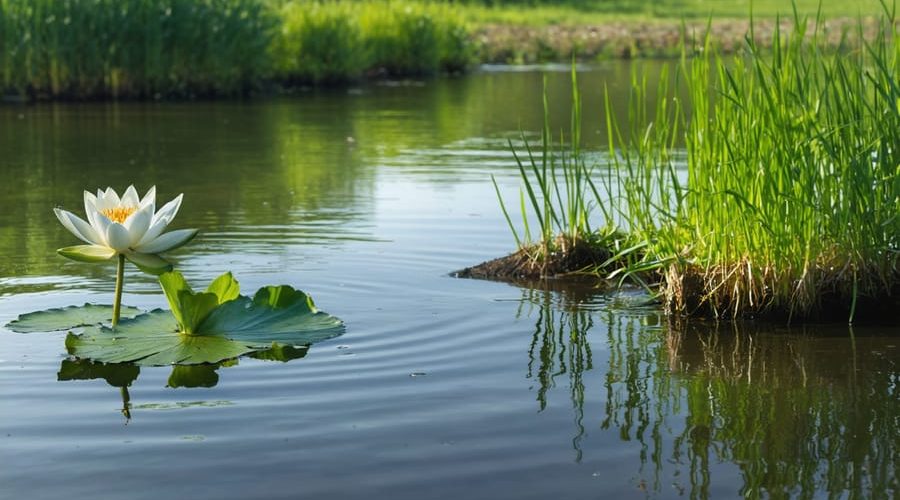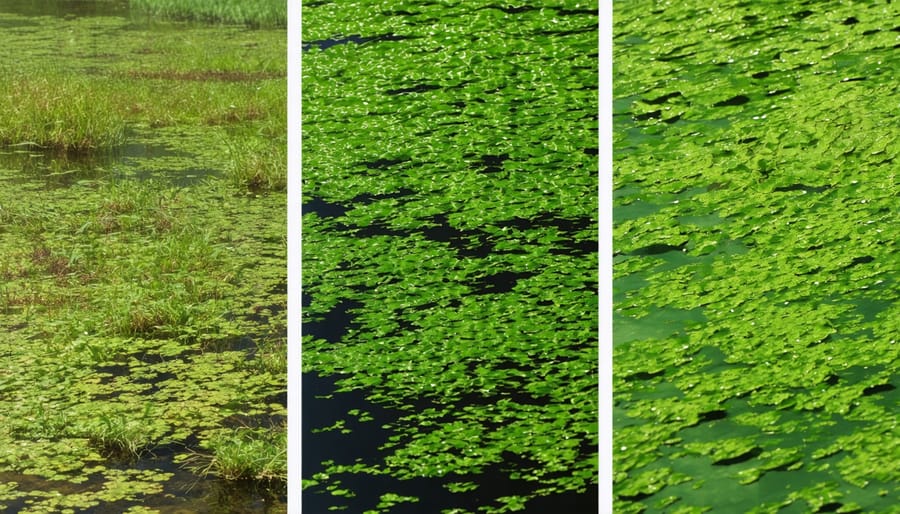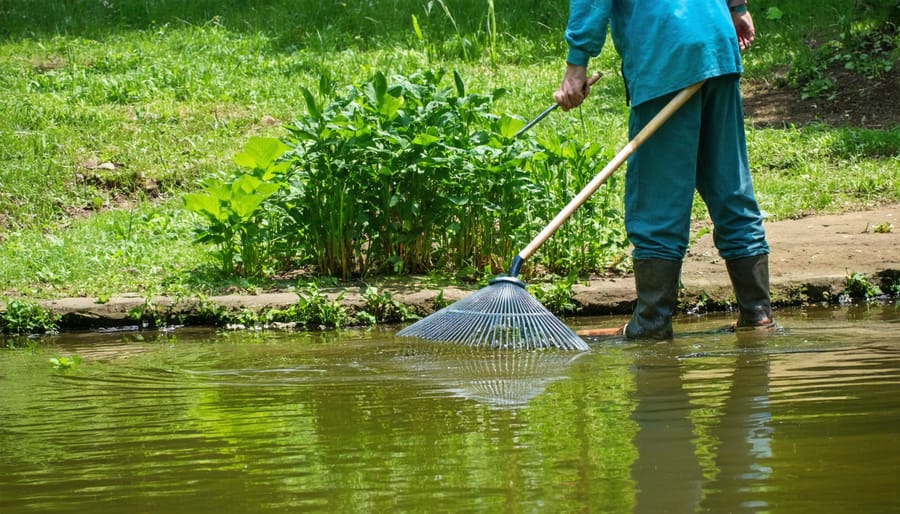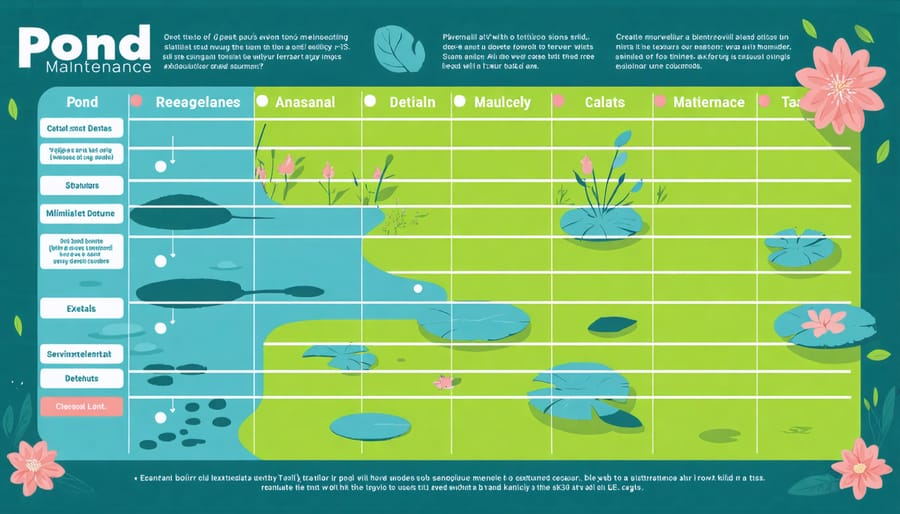
Take Control of Your Pond’s Invasive Plants (Without Harming Your Fish)
Tackle aggressive aquatic vegetation with a multi-pronged approach that preserves your pond’s delicate ecosystem. Mechanical removal using rakes and skimmers provides immediate results for surface-level plants like duckweed and water hyacinth. Deploy biological controls such as grass carp to naturally manage submerged vegetation without harsh chemicals. Install bottom barriers in high-growth areas to prevent invasive plants from taking root while maintaining essential oxygen flow for fish populations.
Managing pond vegetation requires careful balance – too little can starve fish of oxygen and shelter, while excessive growth chokes waterways and disrupts recreational activities. Understanding your specific plant species and implementing targeted control methods ensures long-term success without compromising water quality or wildlife health.
Prevention remains the most cost-effective strategy: maintain proper water depth, reduce nutrient runoff from surrounding landscapes, and regularly monitor water conditions. When intervention becomes necessary, start with the least invasive methods first, progressing to more intensive treatments only when needed.
This comprehensive guide will help you identify problematic plants, choose appropriate control methods, and maintain a healthy, balanced pond ecosystem that enhances your property’s beauty and functionality.
Identifying Problem Plants in Your Pond
Common Invasive Aquatic Plants
When it comes to identifying invasive pond plants, there are several notorious troublemakers you should watch out for. Duckweed, while tiny and innocent-looking, can quickly carpet your entire pond surface. These small, floating plants multiply rapidly in warm conditions, blocking sunlight and oxygen from reaching deeper waters.
Eurasian watermilfoil is another common invader that creates dense underwater forests. Its feathery leaves can grow up to 20 feet long, entangling swimmers and boat propellers while choking out native plants. You’ll often spot it forming thick mats just below the water’s surface.
Algae, though naturally present in most ponds, can become problematic when conditions favor excessive growth. The two main types you’ll encounter are string algae, which forms long, green threads, and planktonic algae, which turns water into a murky, pea-soup appearance.
Water hyacinth, with its attractive purple flowers, might seem like a desirable addition, but don’t be fooled! This floating menace can double its population in just two weeks, creating dense mats that block waterways and decrease oxygen levels.
Remember, these invasive plants often hitchhike on boats, fishing equipment, or even birds, making regular monitoring essential for early detection and control.

Beneficial vs. Harmful Plants
Maintaining a healthy pond requires striking the right balance between beneficial and harmful aquatic plants. While some plants are essential for your pond’s ecosystem, others can quickly become a nuisance. Among the most problematic aquatic invaders are duckweed and water hyacinth, which can quickly overtake your pond.
Beneficial plants like water lilies, rushes, and submerged oxygenators help maintain water quality, provide shelter for fish, and naturally filter excess nutrients. These plants also create beautiful focal points and help prevent algae growth by competing for resources. Keep these plants, but maintain them through regular pruning to prevent overcrowding.
On the harmful side, watch out for aggressive spreaders like salvinia, hydrilla, and common reed. These plants can reduce oxygen levels, block sunlight, and harm fish populations. Remove these immediately when spotted, being careful to collect all plant fragments to prevent regrowth. When in doubt about a plant’s identity, take a photo and consult your local extension office or pond specialist before taking action.
Safe Control Methods for Your Pond
Physical Removal Techniques
Physical removal is often the safest and most environmentally friendly way to control unwanted aquatic plants. Hand-pulling is the most straightforward method – simply wade into shallow areas or work from the shore to grasp plants near their base and pull them up, roots and all. For best results, work slowly and steadily to avoid breaking the plants into fragments that could re-root elsewhere.
For larger areas or deeper water, specialized tools can make the job easier. Long-handled rakes work well for pulling floating vegetation toward the shore, while weed cutters can tackle submerged plants. A weed rake with sharp tines is particularly effective for removing plants like watermilies and their root systems.
Mechanical methods become necessary for extensive plant growth. Weed harvesters – essentially underwater lawnmowers – can clear larger areas quickly. These machines cut plants below the water surface and collect them for disposal. While effective, mechanical removal usually requires periodic repetition as plants regrow.
Remember to dispose of removed vegetation properly by composting well away from the water or bagging for disposal. Never leave pulled plants on the shore, as they can wash back in or decompose and release nutrients that fuel new growth.
Timing is crucial for physical removal. Early spring, before plants reach full growth, is ideal. This prevents them from developing seeds and makes the task more manageable. Regular maintenance throughout the growing season helps prevent vegetation from becoming overwhelming.
A few tips for success: wear appropriate water gear, work on calm days when visibility is good, and take breaks to avoid fatigue. Most importantly, be patient – physical removal takes time but provides long-lasting results without chemical concerns.

Biological Control Options
Biological control is one of the most natural and environmentally friendly ways to manage aquatic vegetation. The most popular option is introducing grass carp, which are voracious plant-eaters that can significantly reduce unwanted vegetation. These fish are particularly effective against common nuisance plants like duckweed and watermeal, though they should be used carefully as they may also consume desirable plants.
Another effective biological control agent is the water hyacinth weevil, which specifically targets water hyacinth – a notorious invasive species. These tiny insects feed exclusively on their target plant, making them a safe choice for ponds with other vegetation you want to preserve.
For those dealing with algae problems, tilapia can be an excellent choice in warmer climates. These fish consume various types of algae and can help maintain clearer water. However, they don’t survive in cold temperatures, so they’re best suited for seasonal use in most regions.
When considering biological control, it’s essential to check local regulations first. Many areas require permits for grass carp, and some biological control agents may be restricted in certain regions. Start with a small number of control agents and monitor their impact over time. This prevents overcontrol, which could leave your pond too bare and affect its ecological balance.
Remember that biological control typically works more slowly than chemical methods but offers long-term, sustainable results. For best results, combine biological control with other management strategies, such as proper nutrient management and regular maintenance of your pond’s ecosystem.
Safe Chemical Solutions
When dealing with aquatic vegetation, chemical solutions can be effective while still maintaining responsible pond management. Modern aquatic herbicides have come a long way, offering fish-friendly options that target specific plant species while leaving beneficial vegetation untouched.
Copper-based treatments are particularly effective against algae and work well in smaller ponds. Just remember to check your water’s pH before application, as copper treatments work best in slightly acidic conditions. For stubborn floating weeds like duckweed, products containing fluridone provide excellent control when used according to package directions.
For submerged vegetation, look for products containing diquat dibromide. This fast-acting herbicide breaks down quickly in water and won’t harm your fish when used properly. Always choose products specifically labeled for aquatic use – never use regular garden herbicides in your pond!
Here’s a helpful tip from my years of pond keeping: apply treatments early in the morning when oxygen levels are highest and water temperatures are cooler. This reduces stress on fish and increases the treatment’s effectiveness. Also, treat only one-third of your pond at a time to maintain safe oxygen levels for your aquatic friends.
Before using any chemical solution, test your water parameters and document them. This helps you monitor the treatment’s impact and maintain optimal conditions for your pond’s ecosystem. Most treatments work best when water temperatures are above 60°F (15°C).
Remember to remove dead plant material as it decomposes to prevent oxygen depletion. Keep your aerator running during and after treatment to maintain healthy oxygen levels. While chemical solutions offer effective control, they work best as part of a comprehensive approach that includes proper maintenance and preventive measures.
Always read product labels carefully and follow dosage instructions precisely. When in doubt, start with a lower concentration – you can always add more if needed, but overdosing can harm your pond’s delicate balance.
Prevention Strategies
Water Quality Management
Maintaining proper water quality is your first line of defense against unwanted aquatic vegetation. Think of your pond as a balanced ecosystem where nutrients play a crucial role. Too many nutrients, especially nitrogen and phosphorus, can trigger explosive plant growth and algae blooms.
Start by testing your water regularly using a basic pond testing kit. Ideal phosphate levels should stay below 0.02 ppm, while nitrates should remain under 10 ppm. If you find these levels creeping up, it’s time to take action.
Several practical steps can help manage nutrient levels:
Install a good filtration system and clean it regularly to remove excess nutrients. Add beneficial bacteria to your pond – these microscopic helpers break down organic matter before it can fuel unwanted plant growth. Consider using phosphate removers in areas with naturally high phosphate levels.
Be mindful of what enters your pond. Avoid over-feeding fish, as uneaten food breaks down into nutrients. Create a buffer zone of land plants around your pond to catch nutrient-rich runoff. Remove fallen leaves and debris promptly before they decompose in the water.
For larger ponds, introducing floating plants like water lilies can help. They compete with unwanted vegetation for nutrients while adding beauty to your water feature. Remember to maintain about 60% surface coverage with these beneficial plants.
Regular water changes of 10-15% monthly help dilute excess nutrients. If you’re using tap water, let it sit for 24 hours before adding it to your pond to allow chlorine to dissipate naturally.
Seasonal Maintenance Tips
Keeping aquatic vegetation under control requires different approaches throughout the year. In spring, focus on removing dead plant material and preparing your pond for new growth. This is also the perfect time to implement preventive maintenance strategies before problematic plants take hold.
Summer calls for weekly monitoring and trimming of fast-growing vegetation. Keep floating plants like duckweed in check by removing excess growth with a net, aiming to cover no more than 60% of your pond’s surface. Consider adding beneficial bacteria during this peak growing season to help maintain water quality.
As autumn approaches, remove falling leaves before they sink and decay. This is crucial for preventing excess nutrients that fuel unwanted plant growth next season. Trim back marginal plants and remove any dying vegetation to prevent debris accumulation.
Winter maintenance is minimal, but still important. Remove any ice build-up to ensure proper gas exchange, and clear dead plant material when possible. Use this quieter season to plan next year’s vegetation management strategy, perhaps considering the addition of bottom barriers or biological controls for problem areas.
Remember to maintain consistent water testing throughout the year, as nutrient levels directly impact plant growth. Adjust your feeding schedule and filtration accordingly to keep your pond’s ecosystem balanced and healthy.

Managing aquatic vegetation is an ongoing journey that requires patience, dedication, and a balanced approach. By implementing the various control methods we’ve discussed – from manual removal to biological controls and careful chemical treatments – you can maintain a healthy and beautiful pond ecosystem. Remember that some aquatic plants are beneficial and essential for your pond’s health, providing shelter for fish and helping to maintain water quality.
The key to successful pond management lies in prevention and regular maintenance. Monitor your pond regularly for early signs of excessive plant growth, maintain proper nutrient levels, and ensure adequate water circulation. Consider creating a seasonal maintenance schedule to stay on top of potential issues before they become overwhelming.
As responsible pond owners, we must always prioritize environmentally friendly solutions and consider the long-term impact of our management choices. Whether you’re dealing with duckweed, algae, or invasive species, there’s always a solution that can work within your specific situation and budget.
Don’t be discouraged if you don’t achieve perfect results immediately. Pond management is a learning experience, and what works best for your pond may take some trial and error to discover. With consistent effort and the right approach, you can create and maintain a balanced aquatic environment that provides enjoyment for years to come.
Remember, a healthy pond is all about balance – not complete elimination of all vegetation. Keep this goal in mind as you work toward creating your ideal water garden.
